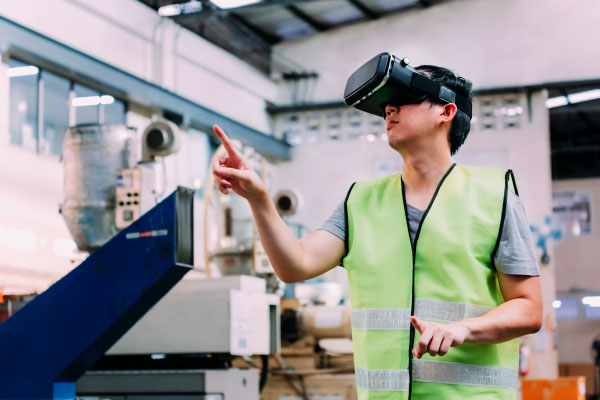6 Ways AR/VR Will Disrupt Manufacturing Industry in Next 5 Years
by Abin Thomas, on Sep 8, 2020 2:07:44 PM
Manufacturing is one of the key fulcrums of the global economy that has been aggressively adapting to Industry 4.0, changing the whole paradigm for entrepreneurs and AR/VR tops the list. According to PwC research, the use of VR/AR in product and service development could deliver a $360 billion GDP boost by 2030.

The modern-day globalized manufacturing ecosystem demands real-time data exchange between the nodes that form a product development lifecycle, for instance, setup planning, design, assembly, production scheduling, machining, etc., along with a hassle-free task collaboration of these nodes. AR/VR in these settings finds the most relevance given the versatility of its stimulative and immersive potential.
In this blog, we will take a deeper look at how this potential is helping the manufacturers gain a competitive edge in amplifying their business value.
Key Use Cases of AR/VR Apps in Manufacturing
Safety of Workers
AR/VR is actively contributing to strengthening the safety of factory workers. A VR simulation of a factory plan in an app can enable workers to identify hazardous situations and hence avoid them in real-time. Moreover, VR apps can be designed to educate workers about safety protocols and offer them real-time visualization to implement the training modules. For example, certain manufacturers are creating avatars or digital versions of the factory workers in order to examine the areas that could cause excessive strain on their employees’ backs during assembly.
This also ensures the safety of sensitive and expensive equipment as operators learn to interact with them in virtual conditions. This largely minimizes the rate of accidents, enhances operator training with instant feedback for real-time scenarios.
Product Design
Attention to detail and efficient production processes are key drivers of success in manufacturing. However, visualizing the entire process of heavy equipment manufacturing becomes crucial, but is elusive for workers, hence delaying the total time of manufacturing by weeks if not months. AR/VR is bridging this gap by offering a visual depiction of the final product outcome before it is actually made. For instance, Ford Motors, the pioneer in using AR/VR technology in manufacturing uses Ford Immersive Vehicle Environment or FIVE virtual reality technology to create detailed virtual representations of under-assembly vehicles. These designs are fed into the virtual car settings, letting engineers see how the interiors of the car would actually turn out.
Quality Assurance
Quality assurance in manufacturing involves keeping a bird’s eye view of the entire workflow. A VR app can help workers keep track of hundreds of small details that are responsible for the quality of the product. With AR apps, costs of hazard prevention, appraisal, internal or external failure can be minimized considerably, as it would add an extra step of audit that was otherwise impossible for a human worker. Across an organization, AR/VR apps can help send messages and updates on quality assurance to workers with an exact depiction of the problem in real-time. Moreover, virtualizing products prior to a physical prototype creation lets manufacturers share the product with customers in the testing phase, thereby forming a better collaborative relationship.
Products Assembly
AR/VR apps can help make assembly of the products faster and efficient. Hands-free workers who otherwise would have to consult a manual or device can simply access data related to product assembly on VR/AR-enabled apps. These apps can also help monitor a complex assembly processes ensuring a sequentially apt assembly of all parts. They can set up voice commands or gesture-based commands to simply receive the information on the product assembly. This can help save several minutes when done on a macro-scale across all processes in a factory.
Machine part auditors can photograph the problematic part of the machine, add an audio record of the problem and share data with the assigned co-worker in no time.
These apps can also be equipped with smart readers that can scan barcodes on supply containers and inventory boxes to provide content details as well as the destination or origin information.
Inventory Management
Clubbed with AI algorithms, AR/VR can streamline the complex process of managing inventory databases, easing the task of picking a product from a warehouse shelf and matching the demand with enough supplies. AR technology can help eliminate location confusion of a product in the warehouse and make this process quick and precise. A warehouse worker with a smartphone can get instructions on the exact location of an item and is guided to the very aisle and shelf where it is stored.
Remote Maintenance
AR/VR apps can help workers perform maintenance routines on the parts or equipment remotely. For instance, a field technician can relay the machine part image in real-time to a remote co-worker and share relevant data or instructions which would serve as a digital repair manual. Caterpillar Inc., an American machinery manufacturer successfully finished a project that required AR for the tasks of machine maintenance. The company owns a private AR app that helps technicians to perform service and maintenance checks. The app is independent of hardware and can be used on a phone, tablet, or AR glasses. It essentially provides consecutive instructions to technicians to carry out the tasks of maintenance on machines.
Conclusion
The immersive power of AR/VR holds immense potential to revolutionize and magnify the manufacturing process across a number of industries. Moreover, as the application of these technologies intensifies and becomes widely accessible, the next five years could become critical in the sustenance of financially challenged small and medium-scale enterprises.
Hence, AR/VR can help entrepreneurs envision multiple micro improvements in efficiency, cost, and productivity in the manufacturing process and hence stay competitive. For long-term expert advice on how to leverage various use cases of AR/VR through channels like smartphones and tablets, get in touch with an augmented reality app development company.

















